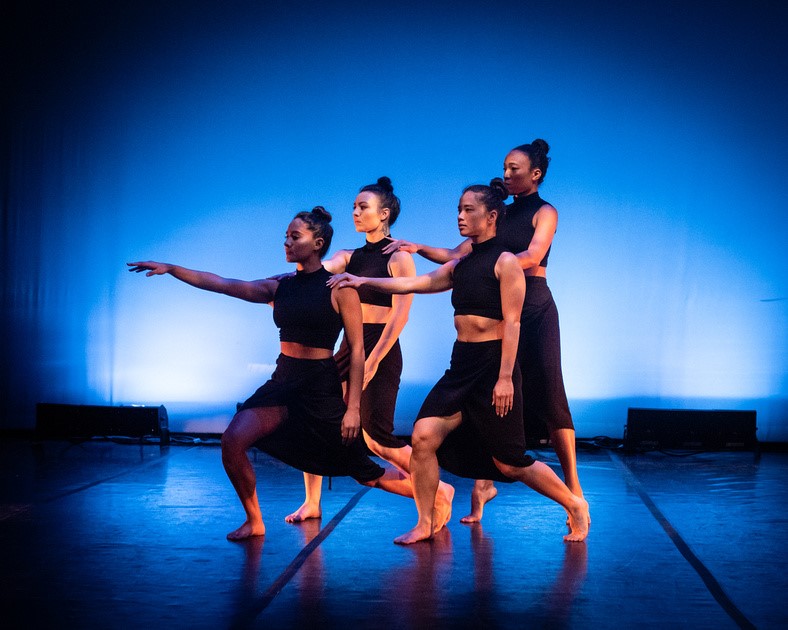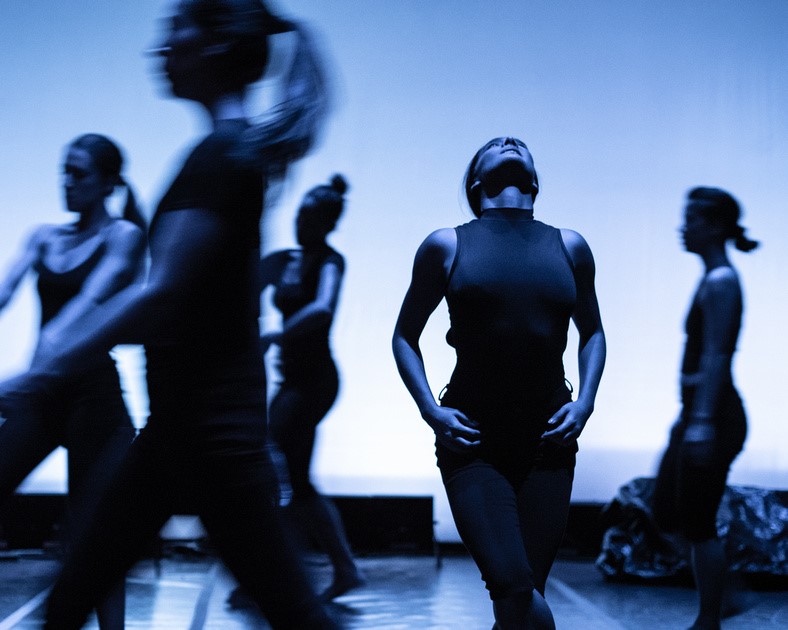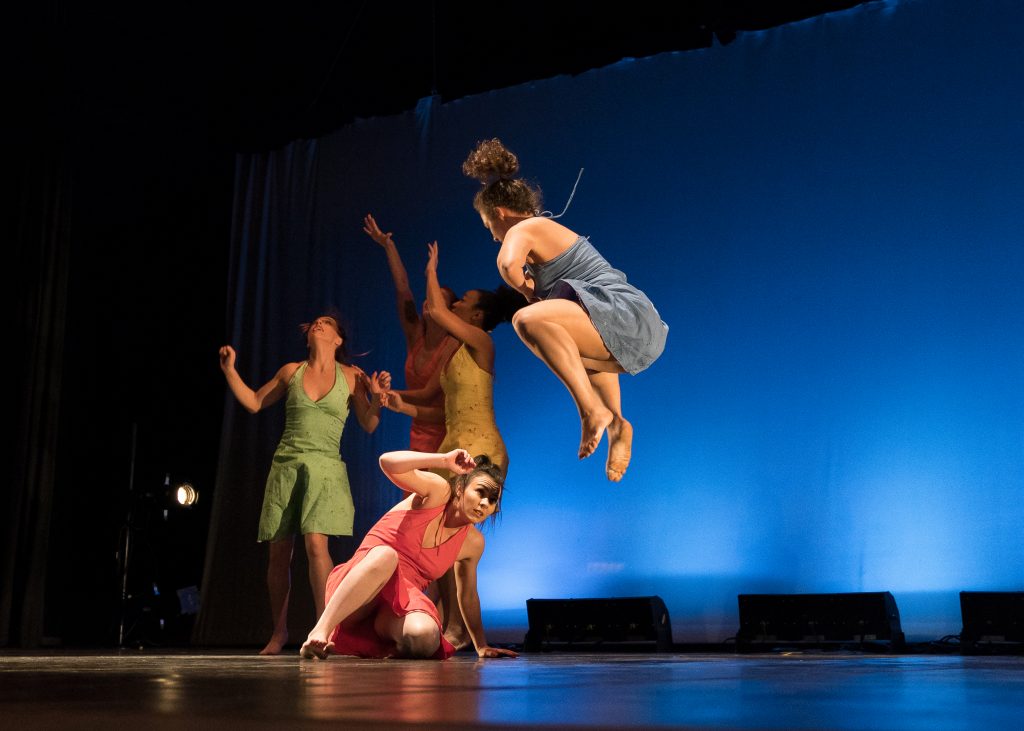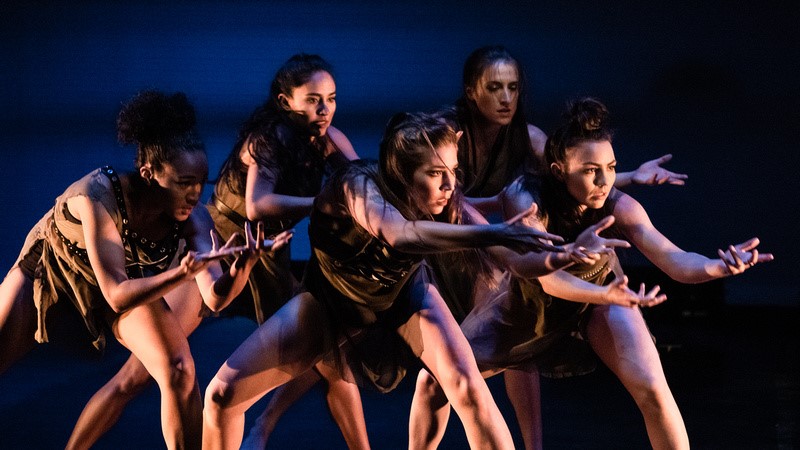Driven by Ritual, Ladies of LITVAKdance Light up Encinitas
Sadie Weinberg has experimental dance in her DNA—her mother is San Diego dance pioneer Betzi Roe–and after decades of study and performance, Weinberg the choreographer has become a magnet for talented movers and conceptual ideas.

LITVAK dancers Maria Jose Castillo, Beverly Johnson, April Tra and Korey Van Hoy perform “Ritual: The Ezio Suite Continues” Image: Jim Carmody
Her new repertory company LITVAKdance presented works by five choreographers at San Dieguito Academy Performing Arts Complex (Nov. 17 and 18). In the lobby, we eyed images of LITVAK dancers from four photographers, and the reception for this sold-out fall concert in the troupe’s beach city home of Encinitas was exhilarating.
The program of six dances opened with Weinberg’s “Ritual: The Ezio Suite Continues,” an extension of two pieces presented at UC San Diego in May, and set to music by Ezio Bosso which sets a dark cinematic tone.
Four women lean forward and cautiously slide their feet over the floor, as if checking for cracks in a frozen pond. As they scoop their arms upward and roll their heads, they evoke women struggling to harvest grain.
There are no props, and the simplicity and clean lines are enthralling. As the women shift and glide, their unison and focus remain intact. We imagine them as sisters, gazing into a river to see their reflections. When they bite the air, tension builds and thoughts turn to starvation and inequalities.
Dancers in “The Enzio” saga include: Maria Jose Castillo, Beverly Johnson, Korey Van Hoy, and April Tra. Dance aficionados will recognize Tra and her commanding presence from Evoke Dance Theater. If you missed it, don’t fret. The work will surely return, along with parts one and two, as a full-length piece on a large stage.
There was a time when Weinberg presented works about and with her children that were too literal. She has evolved. Her brief solo “For My Eldest Son” is a pleasing and playful snapshot of Weinberg and fascinating floor patterns. Spare and sharp, Weinberg cradles her arm and walks in geometric lines, and for this program, Fontaine Laing, a beloved pianist and favorite neighbor, plays Bizet.
The precision of lines and smooth production continued as dancers applied blue tape down the center of the stage. The sounds of smoothing it down and the “thud thud thud wisk wisk wisk” of feet prepared us for the strange fantasy “Tarpaulin”–but never explained the plastic tarp.

“Tarpaulin” by Madboots Dance was originally set for men. Litvak ladies make it their own. Image: Jim Carmody.
Choreographed by MADBOOTS DANCE/Jonathan Campbell and Austin Diaz, “Tarpaulin” was created for a male company to explore queer themes and male identities, but the ladies of LITVAK didn’t get the memo.
Side and back lighting washes exquisite female bodies posing in a bluish fog, as Ms. Laing plays Liszt’s “Romance Opourquoi donc” in E minor. We can’t see their faces, only frantic forms as they burst and stop. They hold impossible extensions. A woman in a headstand folds her legs downward like the hand of a slow clock.
Yoga poses and Grecian statues are cast off when lights brighten. With a new freedom, the women shake out their tight hair buns and swish their locks for a final pose, leaning on each other’s shoulder. It’s a memorable vision, and the image used on the program, yet we are also left to ask, “What’s up with the wrinkled tarp? Why didn’t they touch that giant baked potato?” They didn’t need the material to protect them.
If that is an enigma, “Constant Trio,” directed by Eric Geiger of UC San Diego, and generated by Jess Humphrey and Leslie Seiters, is a challenging game of three-dimensional chess.
Geiger has described it as “movement that demands responsible citizenship by making space for otherness.” At first glance, it seems to be a story about feuding neighbors and gardening. We hear machine noises, which could be leaf blowers, and we see Weinberg in brilliant green slacks, which could be, we don’t know. She hovers over Tra dressed in blue shorts and Emily Miller dressed in a brilliant flowery frock.
Gotcha. They are weeds that need to be removed. Or perhaps they need to be replanted elsewhere. Weinberg’s performance is burned to memory as Ms. Green Jeans.
In a provocative sequence Weinberg kicks and rolls the women with her feet, and the piano score sounds more like a piano being tuned. Still, we are drawn into this potent allegory and seemingly loose, but highly structured used of space.

Emily Miller levitates in “Centrostalgia.” Image: Doug McMinimy
“Centrostalgia” seemed out of place in this concert. Choreographer Amanda Nora Legbeti created the work to explore a girl’s journey to womanhood, and the women of LITVAK danced with joy in colorful sundresses, but all that sunny drama felt juvenile in the realm of “Mama Mia!”
Still, this was a precise and rewarding concert. During a pause before the final dance, pianist Ms. Laing played “Somewhere Over the Rainbow.” It gave tech people a moment to change a few gels and viewers could process what they’d seen.

Litvak dancers Ashley Akhavan, Maria Jose Castillo, Beverly Johnson, Berlin Lovio, and Korey Van Hoy perform “Redemption” by Teresa Jankovic. Image: Jim Carmody
In “Redemption,” choreographed by Teresa Jankovic from UC Irvine, five women conjure women in bondage and eventual warriors. Her vocabulary is enhanced by her time as rehearsal director to the late African-American choreographer Donald McKayle, whose work focused on social justice. (I wrote about McKayle for Dance Teacher Magazine). https://www.dance-teacher.com/k-12-donald-mckayle-collaborates-san-diego-school-2392800487.html
The hum of an organ and shadow side lights frame the drama. Women struggle to cross the stage. One drops from exhaustion. Costumes of sheer brown tunics and leather harnesses suggest slavery and human trafficking.
We predict they will form a human bridge and mountain for one to climb, and they do. In action, they look like Star Trek characters, trapped in a weird vortex of stop and go. Just when we wonder how and when resolution will come, a voice says, “This is where I live. This is where I travel…” The score turns to techno-engine sounds, and the dominant theme is bondage is bad.
So it wasn’t the most joyful finale for a company of this caliber, but LITVAK should be on your radar.
The name of the company comes from Weinberg’s husband. Turns out his family immigrated to the United States from Eastern Europe. Like many families, they changed their name, this time from Litvak to Lane, to assimilate.
LITVAKdance is reclaiming histories and building a new dance family in Encinitas. For a list of upcoming productions, visit their website. www.litvakdance.com. Janice Steinberg also reviewed LITVAK the concert in May 2018. http://www.sandiegostory.com/litvak-dance-makes-stunning-debut/
